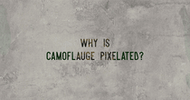Why is Modern Camouflage Pixelated
Sep 5th 2019
![]()
Until recently, camouflage has been traditionally comprised of a collection of misshapen blobs of various sizes using the colors black, green, and brown, all situated against one another to create a pattern. That camouflage design was the military standard for decades and used all around the world. Ever since the 1970s, though, the military has been exploring new ways to make camouflage more effective in the field. After numerous repeated attempts at innovating the design to produce a better version of the pattern, digital camouflage was created.
Digital camouflage was named as such because of the pixelated graphics that were used to create the pattern. By 2002, this new and improved version was being used by the Marines. There were two different types in use, a version that was worn to remain undetected in heavily wooded areas and another that was created for desert landscapes. A few years later, the Army and Navy both adopted the digital patterns, each one relying on a pixelated design that used the predominant color schemes of that military branch. For the Army, it was shades of olive drab and gray. The Marines favoring the traditional green, brown, and black. The Navy incorporating blue, black, and gray into their uniforms.
The Benefits of Going Digital
The term "digital" comes from the pixelated pattern that resembles digitized video images. For the purposes of using such a pattern in creating effective camouflage, the digital aesthetic was first tested out on a large armored personnel vehicle in a wooded area. Painting it in two-inch squares in colors that would blend into woodland landscapes demonstrated distinct advantages. The squares appeared to integrate with each other to make it appear that the APV was barely recognizable against the backdrop of trees from a far away vantage point. Upon closer inspection, the pixelated pattern could also emulate sharper detail with many other aspects of the surroundings. Leaves, branches, shadows, grass, all of it seemed to combine seamlessly with the digital aesthetic. The result was a pattern that would successfully camouflage the APV from short and long distances alike.
The Past and Present
The old camouflage designs were then married to the new pixelated pattern to create a look that achieved the desired effect of fooling the human eye from anywhere. The trick is the digital, boxy edges incorporated into the pattern. The earlier camouflage patterns had curved and rounded edges to the various color blotches within the design, but angling the edges to mimic a digital, traditionally 8-bit video game look, allows for the camouflage to capture and impersonate the details of the environment more accurately. There have even been test cases where the various camouflage patterns of the past and the present were tested for detection time by potential enemies. The current digital designs were shown to be more statistically encouraging than their earlier counterparts, as recognition rates were longer for the pixelated versions by at least two seconds or more. That is a drastic improvement.

